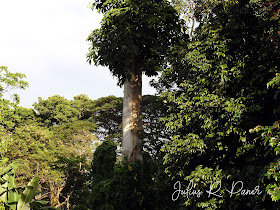This article might be very untimely for posting considering that
COVID-19 is wreaking havoc in the entire Philippine archipelago which
eventually causes downfall to all industries including tourism. But I simply
could not let go of an experience here without giving justice to the memorable
reception provided to us by the management of Lanzones Resort during our visit in Camiguin last month.
Yes, Lanzones Resort is a high-end homestay which I thought could serve
me if I quarantine myself for 14 days and beyond. There is stillness in the
place which suits my taste in an accommodation facility. The indoor amenities
like bedroom, dining room and living room are all spacious, and the frosty blushes
provided natural ventilation which teamed up well with the warm charisma that
translates into Camiguin’s overall local hospitality.
There are small close cottages around the perimeter, all about to be
completed. We stayed in the big house which is surrounded with
huge forest trees and fruit-bearing trees, lanzones among them of course. A
team-building park outside presents a swimming pool, courts of basketball,
volleyball and badminton and a lawn ready for squat in case you need to hug a
verdant landscape.
For a naturalist like me there is no time lost here because Lanzones
Resort provides good venue for backyard birding and walking. These are
activities you could do in between coffee and Instagram breaks. The entire outskirts
serve as garden of common avian species I recorded as follows:
Asian Glossy Starling
Black-naped Oriole
Grey-streaked
Flycatcher
Philippine Pied Fantail
Orange-bellied
Flowerpecker
Red-keeled Flowerpecker
Large-billed Crow
Yellow-vented Bulbul
Eurasian Tree Sparrow
Olive-backed Sunbird
Cattle Egret
Philippine Coucal
Philippine Magpie Robin
Chestnut Munia
White-bellied Munia
Barn Swallow
Pacific Swallow
Barred Rail
Coppersmith Barbet
Brown Shrike
Collared Kingfisher
Brahminy Kite
Blue-tailed Bee-eater
Philippine Coucal
Philippine Magpie Robin
Chestnut Munia
White-bellied Munia
Barn Swallow
Pacific Swallow
Barred Rail
Coppersmith Barbet
Brown Shrike
Collared Kingfisher
Brahminy Kite
Blue-tailed Bee-eater
In this time where
travelling is not the best to undertake, here is praying that the recent crisis
will be over sooner than later so that everything will be back to normal,
including travel and tourism. If this is so, I have to be back in business as
usual and Camiguin will be a sure list in the bucket. I cannot wait to back to
Lanzones Resort.

















































